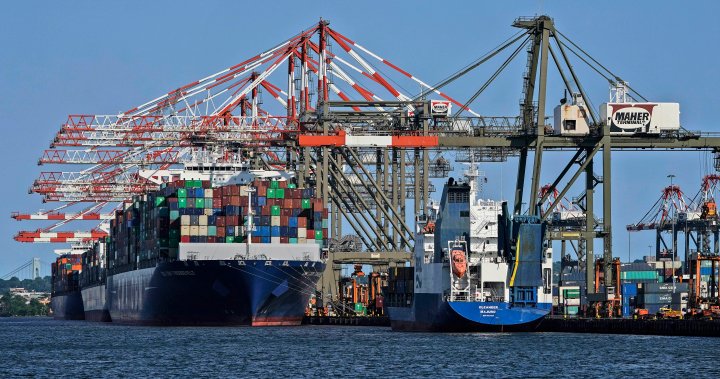The threat of a potential strike at U.S. seaports on the East Coast and Gulf of Mexico is causing concern over further disruptions to supply chains. The International Longshoremen’s Association (ILA), which represents dockworkers at three dozen seaports from Texas to Maine, has threatened to walk off the job on Oct. 1 if a new contract agreement is not reached with the United States Maritime Alliance (USMX) of shipping companies. The potential strike could lead to significant backups of cargo at the ports, impacting supply chains across North America. The Port of New York and New Jersey, the largest East Coast port, handles a much higher volume of goods compared to the main Canadian shipping points on the Atlantic, and experts warn that the impact of a strike could be devastating.
Experts warn that if the eastern U.S. ports were to shut down, the impact would be severe and could result in significant delays. Analysts estimate that it could take anywhere from four to six days to clear the backlog from just a one-day strike. A one-week strike in October may not be cleared until mid-November, and a two-week strike could mean that ports would not return to normal operations until 2025. These potential delays come at a time when supply chains are already recovering from the recent rail shutdown in Canada, further highlighting the fragility of global trade systems.
The shipping industry has been facing a series of challenges beyond just the potential strike at U.S. seaports, including ongoing drought at the Panama Canal and attacks on container vessels in the Red Sea. Inflation has also caused shipping and freight costs to soar since the COVID-19 pandemic, and workers are looking to ensure their wages keep pace. Retailers like Walmart and Target are already rushing goods into the U.S. in anticipation of a potential strike in order to prevent shortages during the holiday shopping season. The West Coast ports are also seeing increased traffic as uncertainty over the East Coast labour dispute grows.
The International Longshore and Warehouse Union (ILWU) on the West Coast recently ratified a new contract that includes significant pay increases over a six-year period. Now, the ILA on the East Coast is aiming for a similar deal as negotiations with USMX continue. Talks between the ILA and USMX broke down over the summer but are set to resume in the weeks leading up to the strike deadline. Both sides have requested federal mediation, and the union has scheduled wage scale meetings for early September. The ILA has expressed concerns about automation and the potential impact on jobs at the ports, while USMX maintains that their proposal aims to modernize and improve efficiency while protecting jobs and hours.
The labour disruptions in Canada’s rail industry and the potential strike at U.S. seaports have raised questions about the need to make commerce activities in all sectors an essential service. Unlike the U.S. Railway Labor Act that ensures no interruptions to rail activity in the event of job action, ports in the U.S. are not covered by similar legislation. The uncertainty created by these labour disruptions not only impacts shippers, exporters, and importers but also ultimately drives up costs that are passed on to consumers. The ongoing challenges facing the shipping industry highlight the importance of stable labour relations and the need for effective resolution mechanisms to prevent future disruptions in global supply chains.


